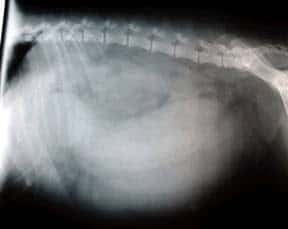
The word pyometra is derived from Latin “pyo” meaning pus and “metra” meaning uterus. The pyometra is an abscessed, pus-filled infected uterus. Toxins and bacteria leak across the uterine walls and into the bloodstream, causing life-threatening toxic effects. The uterus dies, releasing large amounts of pus and dead tissue into the abdomen. Without treatment death is inevitable. Prevention of this disease is one of the main reasons for routinely spaying female dogs.
What Might Make the Veterinarian Suspect this Infection?
Classically, the patient is an older female dog. Usually, she has finished a heat cycle in the previous 1 to 2 months. She has a poor appetite and may be vomiting or drinking an excessive amount of water. In the more usual “open pyometra,” the cervix is open and the purulent uterine contents are able to drip out so that a smelly vaginal discharge is usually apparent. However, there is also a form called a closed pyometra where the cervix is closed. In these cases, there is no vaginal discharge and the clinical presentation is more difficult to diagnose. These patients also tend to be sicker than those with open pyometra due to retention of the toxic uterine contents as well as a longer disease course prior to diagnosis.
Lab work shows a pattern typical of widespread infection that is often helpful in narrowing down the diagnosis. Radiographs may show a gigantic distended uterus, though sometimes this is not obvious and ultrasound is needed to confirm the diagnosis.
How Does this Infection Come About?

With each heat cycle, the uterine lining engorges in preparation for pregnancy. Eventually, some tissue engorgement becomes excessive or persistent (a condition called cystic endometrial hyperplasia). This lush glandular tissue is ripe for infection (recall that while the inside of the uterus is sterile, the vagina below is loaded with bacteria). Bacteria ascend from the vagina and the uterus becomes infected and ultimately filled with pus. Hormonal effects on the uterine tissue accumulate with each heat cycle, which means pyometra is much more common in older females because they have experienced many hormonal cycles.
Traditional Treatment: Surgery
It is especially important that the ovaries be removed to prevent future hormonal influence on any small stumps of uterus that might be left behind. If any portion of the ovary is left, the patient will continue to experience heat cycles and be vulnerable to recurrence.The usual treatment for pyometra is surgical removal of the uterus and ovaries. It is crucial that the infected uterine contents do not spill and that no excess bleeding occurs. The surgery is challenging, especially if the patient is toxic. Antibiotics are given at the time of surgery and may or may not be continued after the uterus is removed. Pain relievers are often needed post-operatively. A few days of hospitalization are typically needed after the surgery is performed.
While pyometra surgery amounts to the same end result as routine spaying, there is nothing routine about a pyometra spay. As noted, the surgery is challenging and the patient is in a life-threatening situation. For these reasons, the pyometra spay typically costs five to ten times as much as a routine spay.
Pros:
- The infected uterus is removed, resolving the problem fast (in an hour or two of surgery).
- With the uterus gone, a pyometra cannot recur
- Remove possibility of unwanted future pregnancy
Cons:
- Surgery must be performed at the time of diagnosis when patient is more critical
- Due to emergent nature, cost is higher than routine spay
Prevention
Spaying represents complete prevention for this condition. Spaying cannot be over-emphasized. Often an owner plans to breed a pet or is undecided, time passes, and then they fear she is too old to be spayed. The female dog or cat can benefit from spaying at any age. The best approach is to figure that pyometra is highly likely to occur if the female pet is left unspayed; any perceived risks of surgery are very much out-weighed by the risk of pyometra.
___________________________________________________________________________________
Feline Pyometra

As with dogs, diagnosis is usually by radiography though ultrasound can be used, particularly if radiography is ambiguous. Treatment for cats is similar to treatment for dogs: surgery is traditional but prostaglandins may be used if it is important to preserve the cat’s ability to breed. Female cats may also fall victim to pyometra. In cats, the disease is just as serious and the treatment options are the same. There is an important difference for cats with pyometra, however: female cats rarely appear sick until very late stages of the disease. The classic creamy vaginal discharge is present and often the belly appears distended because of the size of the pus-filled uterus, but the cat herself is generally eating and grooming as if nothing is much is going on. If the female cat is fastidious and cleans away the discharge, the pet owner may wrongly conclude that she is simply pregnant. Unfortunately, this lack of apparent illness leads to a delay in diagnosis and this delay can be lethal.
_________________________________________________________________________________
A Few Words about Stump Pyometra
After a pet is spayed, there is frequently a small stump of uterine tissue inside the abdomen where the tract has been tied off. As long as there are no female hormones in play, this small stump will be inactive and cannot develop a pyometra. If, on the other hand, there are hormones in circulation, a pyometra can develop in the stump. Symptoms are similar to those for a uterine pyometra, (vaginal discharge, fever, etc.) except that the patient has been spayed sometimes years prior.
Treatment is surgical removal of the infected stump but the real problem is the source of estrogen or progesterone that was necessary to create the condition in the first place. This source of hormone must be identified. Sometimes a small portion of ovary is left behind after spaying, creating what is called ovarian remnant syndrome. This sounds like a surgical error but the situation is usually more complicated and the remnant can be microscopic. Alternatively, there are many estrogen-containing topical products for human use to which a pet can become exposed through licking or cuddling. Occasionally, progestins are used in cats to control skin disease though these have generally been supplanted by newer medications.
Stump pyometra is suspected when a mass is seen on radiographs or ultrasound in the area of the uterine stump and there are accompanying clinical signs of pyometra. If surgery ensues to remove the stump and there is no obvious exposure to a hormone-containing product, the area of the ovaries is explored for evidence of ovarian remnant. If no remnant is visible, sometimes biopsies are taken to rule out microscopic remnants. Once the hormone source is gone, there should be no further pyometra risk.

